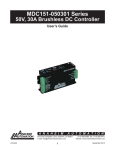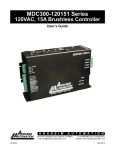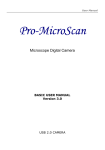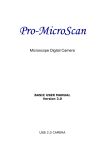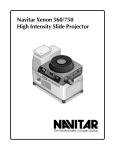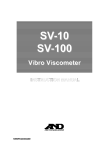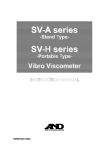Download MDC200-048051 Brushless DC Controller (User`s Guide)
Transcript
MDC200-048051 110VAC Input Brushless Controller User’s Guide A N A H E I M A U T O M A T I O N 910 East Orangefair Lane, Anaheim, CA 92801 e-mail: [email protected] L010404 1 (714) 992-6990 fax: (714) 992-0471 website: www.anaheimautomation.com September 2012 MDC200-048051 Driver Features • • • • • • • • • • • • • • • • Maximum Current Limit Setting from 1 - 5Amps (peak) up to 100W Power Output Internal or External Potentiometer Speed Control 48VDC Motor Voltage Bus 2-Quadrant Operation Hall Sensor Feedback Constant Velocity Mode Short Circuit Protection Requires 85 - 135 VAC Power Input Speed Out Fault Out Brake, Disable and Direction Inputs Selectable Ramp Up/Down Optically Isolated Inputs and Outputs Compact Size (6.25” x 4.35” x 1.93”) Dual Mounting Option Detachable, Screw type Terminal Blocks General Description The MDC200-048051 driver is a velocity control driver designed to drive DC Brushless Motors from a supply of 120VAC. With a motor bus voltage of 48V, maximum phase current of 5A (peak) and power output of 100W, this driver eliminates the need for an external power supply. Using hall sensor feedback, a constant velocity mode can be selected. The driver is protected against over current (cycle-by-cycle or latched), hall sensor error and under voltage. When an error occurs, a fault light is turned on to notify the user. Included on the driver is an internal potentiometer to control the maximum phase current allowed into the motor and an internal potentiometer to control the speed of the motor. An optional external potentiometer (10K) can be used to control the speed as well. The direction of the motor freewheel input. When using the run/stop input, there are three ramp up/down profiles from standstill to select from. The run/stop input overrides all other inputs into the driver. Pin Descriptions The inputs on the MDC200-048051 are optically isolated with an anode (+) and cathode (-) both brought out to the user. With no current going through the Direction, Freewheel, and Run/Stop opto-diodes, the input is considered high. To enable the motor to Run, current must go through the Run/Stop input opto-diode. To Freewheel (remove energy from the motor) the motor, current must go through the Freewheel input opto-diode. To enable the input a minimum of 1.0 mA needs to be sourced or sinked through the opto-diode. This is done simply by placing a voltage of +5 to +7 VDC across two inputs of the opto-diode. If sourcing current into the inputs, then all three cathodes (-) should be tied together and grounded. If sinking current, then all three anodes (+) should be tied together to the +voltage. The PG Out and Fault output on the MDC200-048051 are an opto-decoupled open collector output. When normal operation occurs, this output will conduct current into the emitter. Care must be taken not to pass more than 50mA through this transistor. L010404 2 September 2012 Optically Isolated Inputs and Output The following inputs and output to the MDC200-048051 are Optically Isolated. Item Pin # PG Out 1&2 Direction 3&4 Freewheel 5&6 Run Stop 7&8 Fault Out 9 & 10 To enable an input, apply a DC voltage source of +5VDC to +7VDC across the inputs. The Anodes (+) are pins 3, 5, and 7 and the Cathodes (-) are pins 4, 6, and 8. Absolute Maximum Ratings Output Current Rating: Adjustable 1.0 - 5.0 amperes per phase maximum operating peak current. (0.5 - 2.5 amperes per phase maximum operating continuous current) Power Requirements: (TB4, Pins 1 and 2) 85VAC (min) - 135VAC (max) Operating Temperature: Heat Sink: 0° - 70° C Hall Sensor Power Output: 6.25V @ 30mA maximum. Typical current draw from hall sensors is 20mA. All three Hall Sensor inputs are pulled up through 20K ohm resistors. The external speed control potentiometer must be 10K ohms. Open Loop/Closed Loop (Constant Velocity Mode) The driver can either be set for Open Loop or Closed Loop operation. Open Loop operation is used for applications where the speed of the motor needs to change according to the load. Closed Loop operation is used for applications where speed regulation is needed. Under closed loop operation, the speed is regulated despite changes to the load and the power supply voltage. To operate Open Loop, the O/C LOOP switch (SW1 - pos1) must be in the ‘on’ position. To operate Closed Loop, the O/C LOOP switch must be in the ‘off’ position and the CLADJ potentiometer (R3) and CLADJ dip switches (SW1 - pos2-4) must be set to optimize the driver for each application. The Closed Loop adjustments are needed for faster and slower motor operation, within the restrictions of the motor rated speed. The adjustments provide a direct duty cycle to the driver with respect to the required motor speed. The following tables show Closed Loop potentiometer and dip switch settings for each motor. These adjustments will set the maximum setting of the internal/external speed potentiometer to the motors maximum running speed. If operation at slower speeds is needed for the application, CL POT can be adjusted toward 100% until desired motor speed is achieved. The motor speed can be monitored by measuring the pulse rate of PG OUT (TB2 - pin 1 & 2) L010404 3 September 2012 4-Pole Motors Motor CL1 CL2 CL3 CL POT MAX SPD (RPM) MIN SPD (RPM) BLWR110S-15V-8000 On On On 80% 8000 500 BLWR111S-24V-10000 On On On 50% 10050 825 BLWR112S-24V-3700 On Off On 100% 3735 450 BLWR231D-36V-4000 On Off On 65% 4010 550 BLWR232D-36V-4000 On Off On 65% 4010 550 BLWR233D-36V-4000 On Off On 65% 4010 550 BLWR234D-36V-4000 On Off On 65% 4010 550 BLWR235D-36V-4000 On Off On 65% 4010 550 BLWR232S-24V-1350 Off Off Off 0% 1600 200 BLWS231D-36V-4000 BLWS231S-36V-4000 On Off On 65% 4010 550 BLWS232D-36V-4000 BLWS232S-36V-4000 On Off On 65% 4010 550 BLWS233S-36V-4000 On Off On 65% 4010 550 BLWS234D-36V-4000 BLWS234S-36V-4000 On Off On 65% 4010 550 BLWS235-36V-4000 On Off On 65% 4010 550 Motor CL1 CL2 CL3 CL POT MAX SPD (RPM) MIN SPD (RPM) BLY171S-17V-8000 On On On 0% 7500 500 BLY172S-17V-9500 On On On 0% 9000 500 BLY171S-24V-4000 On On On 80% 4000 250 BLY172D-24V-4000 BLY172S-24V-4000 On On On 80% 4000 250 BLY173D-24V-4000 On On On 80% 4000 250 BLY174D-24V-4000 BLY174S-24V-4000 On On On 80% 4000 250 BLY341D-48V-3200 BLY341S-48V-3200 Off On On 40% 3200 250 BLY342D-24V-3000 Off On On 40% 3000 250 BLY342D-30V-3000 BLY342D-30V-3000 Off On On 40% 3000 250 BLY342D-48V-3200 BLY342S-48V-3200 Off On On 30% 3200 250 BLY343D-48V-3200 BLY343S-48V-3200 Off On On 30% 3200 250 BLY343S-30V-3000 Off On On 40% 3000 250 BLY344D-48V-3200 BLY344S-48V-3200 Off On On 30% 3200 250 BLZ362S-36V-3500 Off On On 10% 3500 330 BLZ362S-160V-3500 Off On On 10% 3500 330 BLZ482S-160V-3500 Off On On 10% 3500 330 BLZ242S-24V-3500 Off On On 10% 3500 330 8-Pole Motors L010404 4 September 2012 Commutation Sequence Step 1 2 Phase A + Z Phase B Z + Phase C - - Hall A 1 Hall B Hall C 3 Step 4 5 6 1 2 3 - - Z + + Z - - Z + + 1 0 0 0 1 1 0 0 0 Phase A - Z Phase B Z - Z Phase C + 0 1 Hall A 1 0 0 1 1 1 120° Hall Spacing Sequence Forward 4 5 6 + + Z - - Z + + + Z - - Z 1 1 0 0 0 1 Hall B 0 1 1 1 0 0 Hall C 0 0 0 1 1 1 120° Hall Spacing Sequence Reverse Step Step 1 2 3 4 5 6 1 2 3 4 5 6 Phase A + Z - - Z + Phase A - Z + + Z - Phase B Z + + Z - Phase C - - Z + + - Phase B Z - - Z + + Z Phase C + + Z - - Z Hall A 1 1 1 0 0 0 Hall A 1 1 1 0 0 0 Hall B 0 1 1 1 0 0 Hall B 0 1 1 1 0 0 Hall C 0 0 1 1 1 0 Hall C 0 0 1 1 1 0 60° Hall Spacing Sequence Forward 60° Hall Spacing Sequence Reverse + = Top Transistor ON, Bottom Transistor OFF, Current Flows into this wire - = Top Transistor OFF, Bottom Transistor ON, Current Flows out of this wire Z = Top Transistor OFF, Bottom Transistor OFF, No current into or out of this wire (High Impedance) Motor Connection Refer to the hookup diagram for typical driver applications. When connecting a motor for the first time, connect the hall sensor wires (5 of them) to the driver. DO NOT CONNECT THE PHASES YET. Turn on power and rotate the motor by hand. If the RED FAULT LED comes on, the hall phases are incorrectly wired. If the RED FAULT LED does not come on then the hall wires are connected correctly. Power the unit down and proceed to connect the motor phases. If the motor does not run or runs erratically, power down and check the speed potentiometer and make sure the phases are connected correctly. There are six different ways to connect the phase wires, and normally only two will allow the motor to rotate, but only one is correct. If the direction of the motor is changed and the no-load current of the motor is approximately the same and the motor runs smoothly in both directions then the phase wires are correct. The wiring of the motor phases should be separated from the hall and input connections to not allow a possible source of interference. L010404 5 September 2012 Terminal and Dip Switch Descriptions Pin # Description Pin # Description Pin # Description 1 Hall Sensor Power 1 PG OUT (collector) 1 AC Hot 2 Hall Sensor A 2 PG OUT (emitter) 2 AC Neutral 3 Hall Sensor B 3 Direction (+) 3 4 Hall Sensor C 4 Direction (-) EARTH GND (must be connected) 5 Hall Sensor Ground 5 Freewheel (+) TB1: Motor Hall Terminals 6 Freewheel (-) 7 Run/Stop (+) Description 8 Run/Stop (-) 1 Phase A 9 Fault Out (collector) 2 Phase B 10 3 Phase C Pin # TB4: Motor Phase Terminals TB3: AC Voltage In Terminals Fault Out (emitter) TB2: Opto-isolated Control Inputs and Outputs SW # Description SW # 1 O/C LOOP 1 INT/EXT SPEED 2 CL1 2 FLT LATCH 3 CL2 3 RAMP 1 4 CL3 4 RAMP 2 5 60/120 SW1: Dip Switch TB# Pin # Description 1 1 Pot (+) Top 3 6 Pot Wiper 3 7 Pot (-) Bottom P1: 10K External Pot Description SW2: Dip Switch Dip Switch Settings Function SW1 SW2 SW3 SW4 SW5 Internal Speed Control (R46) Off --- --- --- --- External Speed Control (TB3 - Pin 6) On --- --- --- --- Over Current Latching --- On --- --- --- Over Current Cycle-by-Cycle --- Off --- --- --- Ramp Profile 1 (4 Sec) --- --- Off Off --- Ramp Profile 2 (2 Sec) --- --- Off On --- Ramp Profile 3 (1 Sec) --- --- On Off --- Ramp Profile 4 (500mSec) --- --- On On --- 60° Hall Sensor Spacing --- --- --- --- Off 120° Hall Sensor Spacing --- --- --- --- On Standard Product (Ready to Ship) Off Off Off Off On SW1: Speed Adjustment, Over Current, and Ramp settings L010404 6 September 2012 Dip Switch Settings (cont.) Function SW1 SW2 SW3 SW4 SW5 Constant Speed Mode (Closed Loop) Off --- --- --- --- Voltage Controlled Speed Mode (Open Loop) On --- --- --- --- Closed Loop Compensation 1 --- --- --- --- --- Closed Loop Compensation 2 --- --- --- --- --- Closed Loop Compensation 3 --- --- --- --- --- Standard Product (Ready to Ship) On Off Off Off Off SW1: Open Loop and Closed Loop. If Closed Loop selected, Closed Loop compensation switches must be set according to the motor speed desired. Motor Freewheel The motor freewheel feature allows the de-energizing of the motor phases. Zero current into this input causes the motor to run at the given speed, while ~1mA into this input causes the motor to coast to a stop. Motor Run/Stop The motor run/stop feature allows the stopping of a motor by shorting out the bottom drives of the three phases. A low at this input allows the motor to run, while a high (open) input does not allow motor operation and if operating causes rapid deceleration. Motor Direction The motor direction feature allows the changing of the rotation of the motor. This input should not be changed while motion is in progress. Zero current into this input causes the motor to turn in the CW direction, while ~1mA into this input causes the motor to turn in the CCW direction. Speed Adjust Setting There are two ways to set the speed on this drive. One is to use the onboard or external potentiometer. To use the onboard potentiometer, set INT/EXT SPD Switch to the off position (default). To use the external 10K potentiometer, set INT/EXT SPD switch to the on position. If an external potentiometer is used to control the speed of the motor, connect the pot wiper to P1 - pin ‘W’, the positive end of the potentiometer to P1 - pin ‘H’ and the negative end to P1 - pin ‘L’. Fault Protection and Fault Output Over current protection can be provided by means of an over current latch function by setting the ‘FLT LATCH’ dip switch. If a motor current level exceeding the current limit set by the internal or external current limit potentiometer is produced, an over current latch is activated, shutting off the output. This driver is equipped with a FAULT LED to alert the user of the following conditions. 1. Invalid Sensor Input Code 2. Over Current. The driver is equipped with cycle-by-cycle current limiting or over current latch. 3. Under-voltage Lockout activation at 9.1VDC for the input voltage and 4.5VDC for Hall Sensor voltage. The fault output on the MDC200-048051 is an opto-deocoupled open collector output. When a latched fault condition occurs, no current conducts into the emitter. When normal operation occurs, this output will conduct current into the emitter. Care must be taken not to pass more than 50mA through this transistor. L010404 7 September 2012 Speed Output The PG OUT terminal (TB2 - pin 1 and 2) is used to determine the speed of the motor shaft. An optodecoupled open collector output is shown at a rate of 4 pulses for 1 revolution of an 8-pole motor, 3 pulses for 1 revolution of a 6-pole motor, and 2 pulses for 1 revolution of a 4-pole motor. Care must be taken not to pass more than 50mA through this transistor. # Poles RPM 8 15 * PG OUT (in Hz) 6 20 * PG OUT (in Hz) 4 30 * PG OUT (in Hz) Heating Considerations The temperature of the heat sink should never be allowed to rise above 70° Celsius. If necessary, mount the unit to an additional heat sink or air should be blown across the heat sink to maintain suitable temperatures. Dimensions L010404 8 September 2012 Typical Wiring Diagram L010404 9 September 2012 COPYRIGHT Copyright 2012 by Anaheim Automation. All rights reserved. No part of this publication may be reproduced, transmitted, transcribed, stored in a retrieval system, or translated into any language, in any form or by any means, electronic, mechanical, magnetic, optical, chemical, manual, or otherwise, without the prior written permission of Anaheim Automation, 910 E. Orangefair Lane, Anaheim, CA 92801. DISCLAIMER Though every effort has been made to supply complete and accurate information in this manual, the contents are subject to change without notice or obligation to inform the buyer. In no event will Anaheim Automation be liable for direct, indirect, special, incidental, or consequential damages arising out of the use or inability to use the product or documentation. Anaheim Automation’s general policy does not recommend the use of its’ products in life support applications wherein a failure or malfunction of the product may directly threaten life or injury. Per Anaheim Automation’s Terms and Conditions, the user of Anaheim Automation products in life support applications assumes all risks of such use and indemnifies Anaheim Automation against all damages. LIMITED WARRANTY All Anaheim Automation products are warranted against defects in workmanship, materials and construction, when used under Normal Operating Conditions and when used in accordance with specifications. This warranty shall be in effect for a period of twelve months from the date of purchase or eighteen months from the date of manufacture, whichever comes first. Warranty provisions may be voided if products are subjected to physical modifications, damage, abuse, or misuse. Anaheim Automation will repair or replace at its’ option, any product which has been found to be defective and is within the warranty period, provided that the item is shipped freight prepaid, with previous authorization (RMA#) to Anaheim Automation’s plant in Anaheim, California. TECHNICAL SUPPORT If you should require technical support or if you have problems using any of the equipment covered by this manual, please read the manual completely to see if it will answer the questions you have. If you need assistance beyond what this manual can provide, contact your Local Distributor where you purchased the unit, or contact the factory direct. ANAHEIM AUTOMATION L010404 10 September 2012










